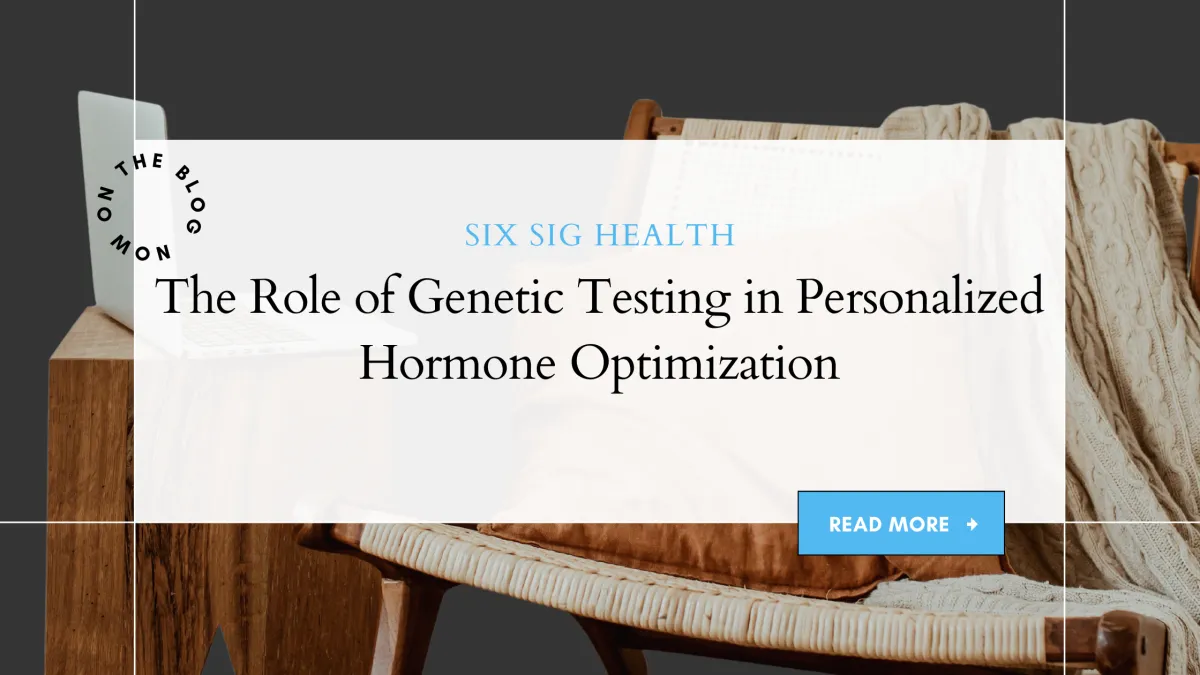
The Role of Genetic Testing in Personalized Hormone Optimization
“Genetics loads the gun, lifestyle pulls the trigger.” – Dr. Pamela Peeke
Introduction: Why Genetics Matter for Hormone Balance
Your hormones don’t just fluctuate randomly—your genetics play a significant role in determining how your body produces, metabolizes, and responds to hormones. While lifestyle factors like diet and exercise influence hormonal balance, your DNA establishes the foundation for your body’s natural tendencies.
With a Six Sigma Health Genetic Test, you can gain deeper insights into your unique hormonal blueprint. By combining genetic testing with the Hormone Key and bloodwork, you can create a truly personalized strategy for optimizing your health.

What the Six Sigma Health Genetic Test Reveals
Unlike standard hormone tests that provide a snapshot of your current hormone levels, genetic testing uncovers your long-term predispositions. Here’s what you can learn:
Metabolism of Carbs and Fats: Are you genetically prone to insulin resistance, or do you efficiently process carbohydrates?
Testosterone and Estrogen Regulation: Do you have a natural tendency for high estrogen or low testosterone?
Cortisol Sensitivity: Are you more susceptible to stress-related fat gain and adrenal fatigue?
Thyroid Function: Do you have a genetic predisposition to thyroid imbalances that impact metabolism?
Detoxification Pathways: How well does your body clear excess estrogen and other hormone disruptors?
Tip: By knowing your genetic strengths and weaknesses, you can adjust your diet, exercise, and lifestyle accordingly to prevent hormonal imbalances before they occur.
Using Genetic Insights to Personalize Your Diet and Exercise
Once you understand your genetic predispositions, you can customize your approach to nutrition and fitness. Here’s how:
1. Optimizing Diet Based on Your Genetic Profile
If you’re prone to insulin resistance: Focus on a low-carb, high-protein diet with moderate healthy fats.
If you have poor estrogen metabolism: Prioritize cruciferous vegetables like broccoli, kale, and Brussels sprouts to support estrogen detoxification.
If you have high cortisol sensitivity: Avoid excessive caffeine and prioritize adaptogenic herbs like ashwagandha and rhodiola.
2. Tailoring Exercise to Your Genetic Makeup
If you have low testosterone production: Strength training with heavy compound lifts can naturally boost testosterone levels.
If you’re predisposed to high cortisol: Swap long-duration cardio for low-impact activities like yoga, pilates, or walking.
If you have slow thyroid metabolism: High-intensity interval training (HIIT) can help stimulate metabolism and energy levels.
Tip: A generic diet or fitness plan won’t give you the best results—genetic data allows for smarter, targeted interventions.
The Power of Combining Genetic Testing, Bloodwork, and the Hormone Key
The most effective approach to hormonal optimization combines three powerful tools:
Genetic Testing: Identifies long-term hormone tendencies and metabolic function.
Bloodwork: Provides real-time data on your current hormone levels.
The Hormone Key: Shows where imbalances are physically manifesting in your body.
By using all three, you can develop a comprehensive, data-driven plan that works with your body’s natural blueprint.
Next Steps: Bringing It All Together
Now that you understand the importance of genetic testing, the next step is interpreting bloodwork results to complement your genetic data. In our next post, we’ll explore which hormone markers to test and how to use bloodwork insights for long-term optimization.
Tip: Don’t rely on guesswork—use your genetic blueprint to build a smarter, more effective hormone-balancing strategy.
Link to Next Post:
See how bloodwork adds real-time insights in Bloodwork: The Missing Link in Understanding Your Hormonal Health
Link to Related Posts:
Pair your genetic insights with lifestyle changes in Lifestyle Strategies for Long-Term Hormonal Health
Use data to create a personalized plan in Creating a Personalized Hormone-Balancing Plan
